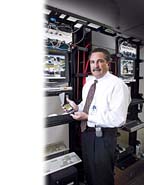School Watch

“The need for a new approach came after an incident in March 2001. We took a hard look at what caused the incident and how physical security could evolve,” said Williams.
The incident he referred to could seem like a distant nightmare to most school districts. Over a two-week period, two separate school shootings wracked the 11-school, 24,000-student district in northeast San Diego County. On March 5, 2001, an 15-year-old freshman killed two students and injured another 13. Later that month, an 18-year-old student opened fire on an administration building, wounding three students and two teachers.
The shootings began Grossmont’s search for a means of better protecting their campuses. Aided in part by funds from Project SERV, a federal disaster program set up after the Columbine incident, the district began working toward healing the wounds from that spring and building a security system that would ensure the urban district would not face such tragedy again.
One of the most important elements is for the system to be able to publish images on the Internet and through wireless connections. The district turned to Sony of Park Ridge, N.J. and its Digital Security Division.
Last summer, Grossmont was the initial reference site for Sony’s e-Surveillance system, which allows administrators and law enforcement officers to act on emergency situations in real-time with digital video surveillance over TCP/IP networks. Sony’s solution consists of fixed and pan/tilt/zoom IP addressable cameras with built-in Web servers and Ethernet ports, Sony Real Shot camera recording and video management software, and network attached servers for storage and archival retrieval. The application software runs on a Cisco Systems’ infrastructure.
Williams instantly liked what he saw.
For this pilot project, he outfitted two of the district’s campuses with the system. JPEG data files could be accessed, monitored, recorded and printed anywhere on the network by authorized personnel – crucial advantages during emergency situations or to help reconstruct events from archived material.
Just a few months into the system’s operation, Williams noted that vandalism and inappropriate use of school facilities and resources had dropped significantly. He also said that cost savings from maintaining the physical plant along with insurance reductions have been some of the unexpected returns from the initial investment.

Starting over
Before the Grossmont shootings, security on the campuses was handled by a local police patrol with officers assigned to cover specific schools and those that feed into it. In addition, as many as seven full-time campus supervisors were responsible for roaming each schools’ grounds. The police and supervisors had recently trained with police and SWAT teams specifically for a school shooting event. After the incident, the district decided that manpower wouldn’t get the job done alone; they needed a real security system.“We understood that if we had been able to see the problem developing – people on the campus that shouldn’t be – perhaps we could have done something. Perhaps we could have gone into an immediate lockdown,” said Williams.
Once the crisis was underway, law enforcement officers were on their own. “They had to go in SWAT fashion from hall to hall. They didn’t know where the shooter was, how many there were. In a lockdown situation, it’s very valuable to have that kind of information.” Williams also noted that events had to be reconstructed from memory only. “It would have been helpful to have evidence of what had happened to design preventive measures.”

“Our first attempt was with a system that really wasn’t ready for the IP infrastructure we had in place. Still, this showed us the potential. We continued our research and found that Sony had the ultimate solution, a perfect fit,” said Williams.

Moving from the plan
The power of the security video solution lies in its ability to deliver real-time visual information over the Internet and automatically communicate alarm events. Motion sensor equipped cameras as well as other triggering criteria (e.g. access control) signal school officials on call. Authorized personnel can then take control of the cameras to immediately investigate a situation from any networked computer. Wireless capabilities allow police patrol cars with laptop and/or handheld computers to continue to keep an eye on events while responding to the scene. All the while, the system records images on a secure, RAID redundant server.“We can program the system to respond to alarm events in numerous ways. It can send e-mail or call a cell phone,” Williams said. “It would be impossible for anyone to monitor all the information coming through the cameras. But the system looks for what’s important. Say the assistant principal is on call at home. If there’s an alarm, they just dial in on a laptop to see what’s going on.”
Initially, plans for the pilot campus system consisted of four Sony SNC-RZ30N pan/tilt/zoom network cameras, connected to the company’s network-attached storage server, running Real Shot camera manager application software over the Cisco Systems network. The system’s 720 gigabyte storage capacity would hold approximately 30 days worth of archived images. As soon as Williams’ team began to appreciate the new possibilities the system afforded, additional cameras were added.
Williams noted that now, aside from security functions, an additional camera can watch or even web-cast sporting events at the school stadium. In time, the system may be used for educational purposes as well. Adding cameras to classrooms will let top teachers demonstrate best practices to their colleagues. The system also helped in confronting students with discipline issues and other non-security facility issues. Williams provides some examples: “The dumpsters behind schools were filled every day. Cameras discovered who was responsible. We were even able to detect a broken sprinkler with the cameras.”
Williams added that the work to build a flawless security system was not over; the district is now working closely with local police to deliver video information via wireless both to cruisers with laptops and to foot patrols with handheld computers. According to Williams, police are confident that the new tools give them what they need to address any future situation.
Saving money
“The system is essentially maintenance-free and training staff to use it is simple,” said Williams. “The price of a single policeman or campus supervisor pays for the whole installation on a campus. The big difference is that those salaries are a recurring cost. Here, after the first year, you’re saving money. At $55,000 per campus multiplied by our 11 campuses, we could see savings of better than half-a-million dollars annually.”Other unexpected benefits have also surfaced. The school district is renegotiating with its insurance underwriters to reflect the changes brought by the new security system. “We’re a safer place now. That we are less likely to have damages should be reflected in our premiums. This is another place where we’re cutting overhead. The insurance savings will likely be significant, enough to justify costs,” said Williams.
Williams remarked that typically, the introduction of a pilot system is followed by lengthy analysis and evaluation but that the system’s success in providing security had immediately won over the district’s governing board. He noted that the pressing issue wasn’t whether to extend the system district-wide, rather, how to allocate funding fast enough to get it in place immediately.
Looking for a reprint of this article?
From high-res PDFs to custom plaques, order your copy today!






